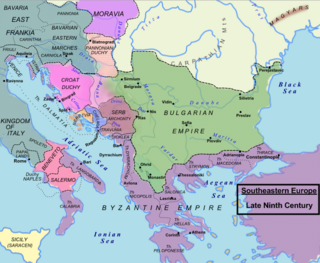 W
WConstantine Bodin was the ruler of Duklja, from 1081 to 1101, succeeding his father, Mihailo Vojislavljević. Born in peaceful times, when the Southern Slavs were subjects of the Byzantine Empire, his father was in 1072 approached by Bulgarian nobility, who sought aid in their revolt against the Byzantines; Mihailo sent them Bodin, who was crowned Bulgarian tsar under the name Petar III joined the short-lived revolt, being captured the following year after initial success. He was freed in 1078, and upon the death of his father in 1081 he succeeded to the throne of Dioclea. Having renewed his acknowledgement of Byzantine overlordship, he soon sided with their enemies, the Normans, which resulted in a Byzantine invasion and his capture. Although he quickly had himself freed, his reputation and influence waned. He was pushed aside into by one of his governors, Vukan, who continued the struggle against the Byzantines.
 W
WThe Church of St Donatus is a church located in Zadar, Croatia. Its name refers to Donatus of Zadar, who began construction on this church in the 9th century and ended it on the northeastern part of the Roman forum.
 W
WThe Theme of Dalmatia was a Byzantine theme on the eastern coast of the Adriatic Sea in Southeastern Europe, headquartered at Jadera.
 W
WDalmatian city-states were the Dalmatian localities where the local Romance population survived the Barbarian invasions after the fall of the Western Roman Empire in the 400s CE. Eight little cities were created by those autochthonous inhabitants that maintained political links with the Byzantine Empire. The original name of the cities was Jadera, Spalatum, Crespa, Arba, Tragurium, Vecla, Ragusium and Cattarum. The language and the laws were initially Latin, but after a few centuries they developed their own neo-Latin language, that lasted until the 19th century. The cities were maritime centres with a huge commerce mainly with the Italian peninsula and with the growing Republic of Venice.
 W
WThe Siege of Ragusa by the Aghlabids of Ifriqiya lasted for fifteen months, beginning in 866 until the lifting of the siege at the approach of a Byzantine fleet in 868. The failure of the siege and the re-appearance of the Byzantines in the region of Dalmatia signalled the beginning of new aggressive western policy by the new Byzantine emperor, Basil I. Its immediate effects were the re-establishment of Byzantine authority there in the form of the Theme of Dalmatia, and the beginning of the Christianization of the Slavs of the western Balkans, but within a few years it led to renewed Byzantine involvement and presence in southern Italy as well.
 W
WSalona was an ancient city and the capital of the Roman province of Dalmatia. The name Salona preserves the language of the early inhabitants of this area whom the Romans called the Dalmatae, considered to be part of a larger group called the Illyrians. Salona is situated in today's town of Solin, right next to Split, in modern-day Croatia.
 W
WSplit is Croatia's second-largest city and the largest city in the Dalmatia region. It lies on the eastern shore of the Adriatic Sea and is spread over a central peninsula and its surroundings. An intraregional transport hub and popular tourist destination, the city is linked to the Adriatic islands and the Apennine peninsula.
 W
WStefan Vojislav was the Prince of Duklja from 1040 to 1043. Beginning in the year 1018, he served as a Byzantine governor, until 1034 when he led an unsuccessful revolt that landed him in a prison at Constantinople. He managed to escape and returned home, this time successfully gaining the independence of his statelet and expanding his rule over southern Dalmatia and its hinterland.